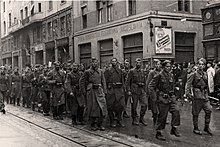| This article includes a list of references, related reading, or external links, but its sources remain unclear because it lacks inline citations. Please help improve this article by introducing more precise citations. (January 2020) (Learn how and when to remove this message) |
| Sarajevo Operation | |||||||
|---|---|---|---|---|---|---|---|
| Part of World War II in Yugoslavia | |||||||
 3rd Yugoslav Partisans' Corps enter liberated Sarajevo, 6 April 1945 | |||||||
| |||||||
| Belligerents | |||||||
|
|
| ||||||
| Commanders and leaders | |||||||
|
|
| ||||||
| Strength | |||||||
| 38,000 men (5,000–18,000 Zeleni Kader/Green Caders) | 50,000 men of which 35,000 Germans | ||||||
| Casualties and losses | |||||||
|
637 killed 2,020 wounded |
5,700 killed and wounded 6,000 prisoners | ||||||


The Sarajevo Operation was an operation by the Yugoslav Partisan Army which led to the liberation of Sarajevo and Central Bosnia in March-April 1945.
The Battle
The German defense plan for Yugoslavia of 22nd of February 1945 had named Sarajevo as a fortified city, which could only be abandoned by direct permission from Adolf Hitler. By 20th of March, the failure of Operation Spring Awakening (the German offensive in Hungary) and the successful offensive of the Yugoslav 4th Army in Lika (North-Western Croatia), made holding Sarajevo pointless. The retreat was ordered, with 3,000 wounded German soldiers from the Sarajevo hospital going first. Interception of Yugoslav wireless communications had revealed to the Germans that the general attack was planned for 28th of March. In order to secure their retreat routes, the German Army carried out the Berggeist, Maigewitter and Osterglocke Operations.
On 28th of March 1945, the Yugoslav Army launched its attack. Under command of the Operational HQ for Liberation of Sarajevo were the 2nd, 3rd and 5th Corps of the Yugoslav army, supported by the 11th and 13th Krajina and 18th Central Bosnian Brigade, an Artillery Brigade and a Tank Company. The overall commander was the commander of the 2nd Corps Radovan Vukanović. Sarajevo and its surrounding areas were defended by German and NDH forces under command of the German 21st Mountain Corps.
After heavy fighting, the city of Sarajevo was liberated on 6th of April.
During the pursuit of the enemy, Yugoslav units liberated Visoko, Kakanj and on 10th of April Busovača, which concluded the Sarajevo operation.
Order of battle
Axis
- XXI Mountain Corps (Ernst von Leyser)
Partisans
- 2nd Corps (Radovan Vukanović)
- 3rd Corps (Pero Kosorić)
- 5th Corps (Slavko Rodić)
- 4th Division
- 10th Division
- Zenica Combat Group
See also
Sources
| World War II in Yugoslavia | |
|---|---|
| 1941 |
|
| 1942 | |
| 1943 | |
| 1944 | |
| 1945 | |
| Croatia | |
| Macedonia | |
| Serbia | |
| Slovenia | |
| Strategic bombing | |